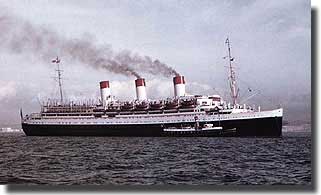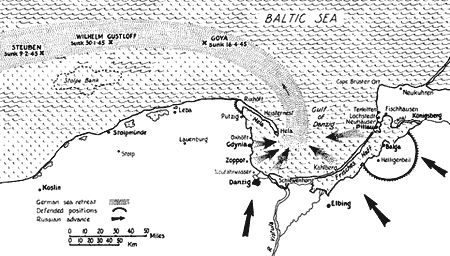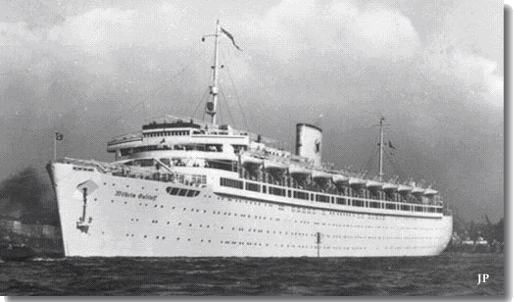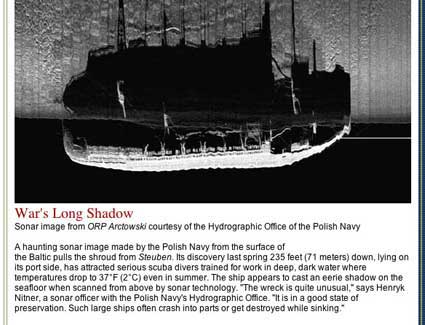|
Tragedy at Sea
During the months of 1945 prior to the surrender of all German Sea. Air, and Land forces to the Allies on May the 8th, a series of disasters at sea happened. A horrific number of deaths resulted, and five German merchant ships were involved. They were:- Wilhelm Gustloff, General Steuben, Goya, Cap Arcona and Thielbeck . Three of these ships were sunk by torpedoes fired from two Russian submarines, and two were dispatched through attacks by British R.A.F. aircraft. When linked together, the loss of life from the sinking of these five vessels added up to between 25,000 and 30,000. The fate of these ships has never been widely disseminated in print, although at least two books The Cruelest Night, and The Damned Don't Drown, have been written about Wilhelm Gustloff, and one, The Dentist of Auschwitz contains a chapter devoted to the loss of Cap Arcona.
Cap Arcona Several sites on the Internet are now playing their part in bringing this story to a much wider audience across the world. One may well pose the question "Why are so many people unaware of these actions and this huge loss of life?" I had stumbled on the story of the sinking of Wilhelm Gustloff in 1997 whilst researching my work Under Water Warfare, The struggle against the Submarine Menace 1939-1945. I had not been aware of this saga prior to this discovery. Further follow up brought to light the fate of four more German Merchant ships. In pondering answers to my own question as to "Why people are generally unaware of the fate of these five ships and the huge loss of life that stemmed from their sinking," the following points come to mind.
Whilst this percentage is not meant to diminish their tragic loss, it may help to put into perspective why so little is known about what happened to these refugees, or why there was no outrage or outcry on their behalf so long ago in 1945. This brief description of these actions is offered in an attempt to help redress the paucity of information available on this subject.
Backdrop to evacuation of refugees The Russians had reached the Oder River, and were but 100 miles from Berlin, and in fact had overrun thousands of German refugees, both civilian and military in these areas. A vast fleet of ships was assembled to rescue these people, and, an incredible 2,116,500 people were picked up to be transported by sea to a safe area. This rescue operation enjoyed over a 98% success rate, and of this total, about half a million were military personnel. When compared to the rescue of the British Expeditionary Force from Dunkirk in 1940, this lift of refugees fleeing from the advancing rapacious Russian army was seven times greater. Let us look briefly at the fate of the five ships involved, who were all sunk with a resulting appalling less of life. Strength through Joy programme KdF planned and provided multi activities for the workers, on the assumption that a contended labor force would be more productive on the home front. Thus, concerts, cultural programs, trips and cruises were all organised. Wilhelm Gustloff was the flagship of those used in the workers cruise programme. Wilhelm Gustloff May of 1939 found Wilhelm Gustloff transporting back to Germany part of the Legion Condor who had fought with Franco's forces in the Spanish Civil War.
In September of that year after war was declared by Britain, Canada, Australia and New Zealand against Germany for her invasion of Poland, this ship was commissioned into the Kriegsmarine as Hospital Ship D, then in November 1940, she was turned into an accommodation vessel anchored at Gotenhafen, the former port of Gdynia, and here it remained until January of 1945. The port of Gotenhafen nestles an the western side of the Gulf of Danzig sheltered from the Baltic Sea by the probing arm of the Hela Peninsula. Also in port were some remnants of the Kriegsmarine, Lutzow, a pocket battleship, Admiral Hipper, a heavy cruiser, some light cruisers, plus a number of destroyers. All were ready to play their role in this mass evacuation from the fast approaching Russian horde. Further east the port of Konigsberg was already under siege, here the cruiser Emden having undertaken an engine refit, was ready to make her escape, but, was suddenly ordered to wait to take on board a special cargo. This turned out to be the remains of Field Marshal von Hindenburg and his wife, Their coffins had been snatched from the Memorial that had stood at Tannenberg, the scene of the Marshall's famous victory, and this city had now fallen to the fast advancing Russians. Wilhelm Gustloff had an unusual command structure, her Captain as a civilian ship was a merchant marine officer, Friedrich Petersen, but as a residential vessel for the 2nd. U-Boat Training Division, she carried Commander Wilhelm Zalm, a naval officer in command.
Hoffmann estimated a company of 7- 8,000 people were loaded, but stated that the exact number were never calculated, in fact, this estimate may well be understating the actual number of people aboard this ship. Because of the vast excess of refugees above the normal number of passengers carried, 40% of all on board were left without any life jackets. At 1230 on the 30th. of January 1945, four tugs eased the Wilhelm Gustloff away from her berth, at last the shIp was moving, they would soon be on their way to safety. One can hear the collective sigh of relief that must have been uttered by her company. The ship shaped a course westwards for the open sea and freedom! The weather was bad, a wind strength of force 7 prevailed, snow was falling, and ice floes were evident in the surrounding waters, and layers of ice commenced to form on the decks of Wilhelm Gustloff. Her only armament, two Anti Aircraft guns hastily mounted on the upper deck. With the heavy weather, below decks became a shambles, as many of the refugees succumbed to sea sickness, the over crowding exacerbating this problem. At 9:10 PM three torpedoes struck the Wilhelm Gustloff fired from the Russian submarine S13 under the command of Alexander Marinesko. Panic ensued as thousands tried to reach the deck space. The ship listed to starboard then righted herself briefly then to take on a heavy starboard list. The first hit had been deep below the waterline and level with the bridge, the second torpedo exploded below the swimming pool area where the 400 Naval Auxiliary women had been housed and most of them died. The third and last torpedo hit amidships in the fore part of the engine room opening up the hull and destroying machinery. The ship was doomed, and the forecastle started to dip below the sea surface whilst the stern rose higher in the air, in only 50 minutes Wilhelm Gustloff had sunk, taking with her in the icy depths of the Baltic about 7000 children, women and men. A flotilla of small German ships in the vicinity managed to pluck 1000 people to safety. Hoffman was among those saved by German Torpedo Boat T-36, he reported that three rescued pregnant mothers gave birth that night aboard that Torpedo boat. All that now remains of this proud ship is a wreck, designated as a mass grave site, making it off-limits to divers. The mid section is badly damaged and crushed, the bow and stern appear relatively well preserved. This wreck of Wilhelm Gustloff survives to remind us all of the single most tragic event in Maritime History, with the greatest loss of life. It now appears that up to 10,000 could have died in that fateful night. Thousands of unnamed people lie at rest to serve a warning to the world that War is Hell and profligate in its demands for human sacrifice. General Steuben Shortly after midnight on February 10th, Captain Alexander Marinesko in Russian Submarine S-13, lined up the second large ship in his periscope in the space of only 10 days. He was convinced he had found a cruiser of the Emden class. Using his stern tubes he fired two torpedoes, both ran truly and hit below the bridge. General Steyben started to sink. Torpedo Boat T-196 had been escort to General Steuben and quickly searched for the attacker but S13 departed the scene with dispatch and made her escape. Within seven minutes General Steuben had rolled over and sunk, but three hundred were being rescued from the icy sea conditions, and it is believed that 3,000 died from this action. Back to the Russian submarine S13, Marinesko had been ordered to return to his base at Turku, where he arrived on the 14th. of February. Here, his superior officer Captain Oryel, informed him that he had sunk Wilhelm Gustloff, and that his second victim was not a cruiser of the Emden class, but another ship trying to evacuate refugees, she was General Stuben.
Along with the Wilhelm Gustloff and the Goya, the Steuben is a Goya In 1943, she was conscripted by the Kriegsmarine as a target vessel serving a U-Boat training program, and late in 1944, this ship had lifted almost 20,000 refugees from East Prussia, making four voyages across the Baltic. On April 16th. 1945, Goya was filled to bursting point with both refugees and survivors from the 35th. Tank Regiment, in all totaling about 7,000 people. The ship was steaming about 50 miles north of the Hela Peninsula and the time was four minute to midnight. The Russian submarine L3 under the command of Captain Konovalov fired two torpedoes which ran truly, hitting Goya amidships. She broke in half and was gone in about four minutes. Some reports suggest 183 survived, and others indicate 334 were saved, but no matter which source one may use, it is estimated in excess of 6,500 died that night. The human cargo aboard Cap Arcona and Thielbeck Many of these inmates from these camps were Jews. Cap Arcona and Thielbeck It is quite ironic that a Jewish immigrant in Germany had been the founder of this ship's original owner, the Hamburg -Amerika Line. Cap Arcona's Captain Hemvick Bertram was forced by 500 German SS guards of these concentration inmates to load 4,500 of them into his vessels holds. The smaller Thielbeck, also anchored in the bay was similarly loaded with these unfortunate people. On May the 3rd. 1945, Royal Air Force aircraft from 83 Group 2nd. Tactical airforce attacked both ships, plus a much smaller, ship Athens which had been used to ferry the prisoners from the shore to the respective ships at anchor. Fire from the attacking aircraft caught the prisoners trapped below decks, Cap Arcona burning furiously rolled onto her side, Thielbeck sank within forty five minutes, and something of the order of 6,000 died from both these ships. It was reported that survivors in the water were gunned down by SS units on shore manning machine guns there. Over the centuries many ships have foundered at sea in varying circumstances with subsequent loss of life, but nowhere in the annals of the sea has there been recorded a single calamity such as the sinking of the Wilhelm Gustloff, which has proven to be the greatest Maritime Disaster in history.
Photo-montage with sound from documentary film |





 Karl Hoffmann (picture at right), a Kriegsmarine sailor and a survivor of the sinking leaves us with this account.
Karl Hoffmann (picture at right), a Kriegsmarine sailor and a survivor of the sinking leaves us with this account.